Recently, the cute animals of the chinchilla are becoming increasingly popular. This wonderful rodent is well established in the conditions of an apartment. The natural habitat of chinchillas is the rocky terrain and highlands of South America, dwelling in such hard-to-reach places, gives little information about their way of life.
But everything is known about the content at home. There are basic rules for caring for chinchillas, and with the right and competent approach, this funny animal will delight you for many years, because in an apartment chinchilla live up to 20 years and more. I want to note that this is a very important fact, because children who buy rodents with a short life span regularly experience stress and suffer a lot of pet death.
Why else should you start a chinchilla at home?
It should be remembered that the chinchilla spends all his time in a cage or window. With the peculiarity of heat exchange of this animal, it is necessary to observe the temperature regime. The body temperature of the rodent is 36 degrees. It is better to put the cell in a room with an air conditioner, do not put it next to the battery, otherwise in the heating season the animal may develop a heat stroke, up to the stop of the heart.
At the same time, eliminate direct air currents, or drafts, and direct sunlight. The habitat of your future pet should be in a cool (with a temperature of 18-20 degrees Celsius), shaded and, most importantly, a quiet place.
But take care of your peace, the animal leads a night life and does not need to put the showcase in the bedroom or in the room with the child, because night walks and games of a fluffy pet can disturb a quiet sleep.
Cell equipment
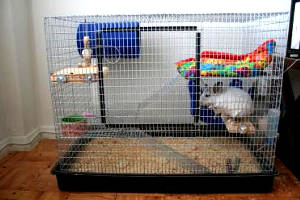 All your life in your apartment, the chinchilla will be held in a cage and therefore the habitat should be spacious, it should be noted that in a cramped environment the beast is very oppressed and this very shortens the life of the fuzzy.
All your life in your apartment, the chinchilla will be held in a cage and therefore the habitat should be spacious, it should be noted that in a cramped environment the beast is very oppressed and this very shortens the life of the fuzzy.
The minimum cell size is 60 to 60 cm, but the larger the showcase, the better for the pet. Locks and latches must be strong and reliable so that the inquisitive animal can not open them and run away from their home. Free walking around the apartment is a great stress for the animal, and carries a lot of dangers, any electric wire can cause the death of a pet.
The main components of the cell:
- For chinchillas, you can not put drinkers in the form of cups or pots, the animal can turn them over and pour the water. The drinking bowl must be made of quality plastic that does not allow water to pass through. If you get a ballpoint drinker, observe that water does not accumulate under it, otherwise the animal will wet its hair. European drinkers are made of high-strength plastic, a stainless steel nozzle, they do not flow and give out the right amount of water strictly on demand. Experienced breeders recommend nipple drinkers. The drinkers for water are attached to the display window with the aid of suction cups or screws.
The drinker must be regularly disinfected. It is good to do this with the help of baking soda, then rinse with running water and rinse with boiling water. Choose a drinker, which is convenient to attach and regularly remove and wash, and also top up with fresh water. By the way, there are molds in which the top cover is removed.
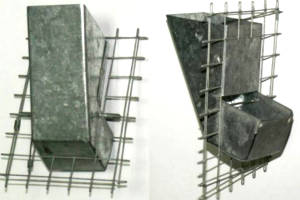
Cleaning in the cage needs to be done regularly, general cleaning should be done at least once a week, disinfection should preferably be carried out with an ultraviolet bactericide lamp, drinkers and feeders should be washed with soda and boiled water.
Feeding chinchillas
![]() Buying this cute little animal for care at home, you need to remember how they live in nature and what they eat. The gastrointestinal tract is represented by a very long tube, and any deviation in diet from normal has serious consequences for the health of the pet.
Buying this cute little animal for care at home, you need to remember how they live in nature and what they eat. The gastrointestinal tract is represented by a very long tube, and any deviation in diet from normal has serious consequences for the health of the pet.
Chinchillas are pure phytophages, that is, they eat only plant food. In conditions of high mountains, the main diet is mountain grass, branches and various cuttings. Long intestines help to take from such a diet maximum nutrients and calories. It turns out that the rough and poor forage of high mountains became a full-fledged food of wild relatives of domestic chinchillas. Think the fodder base in the conditions of the apartment to the smallest detail.
The first and golden rule, this introduction of a new feed should be gradual and you need to start with a small amount. Food should be varied, rich in fiber, vitamins and mineral nutriments. In the feeder should not be fatty, high-protein, sweet and very high-calorie foods.
Feed chinchill once a day, usually in the evening, more often after six o'clock in the evening. It is better to accustom the animal to the same time, the regime is very important.
There is a large number of different formulations for self-made food for rodents. It should be noted that this is a very time-consuming and time-consuming process. All ingredients should be quality, without a musty smell and signs of rot, it is better to buy the entire grain base from trusted suppliers. Storage, pre-cooked with a stock of feeds requires the holding of the right conditions, without moisture and dust, it is better to use special containers.
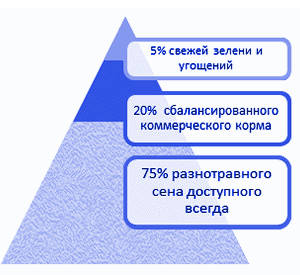 But in our time, fuss, preparing feeds yourself is not always convenient and easy. In such cases it is better to use ready-made granules. Such concentrated feeds are easily assimilated by small animals, on average 2 incomplete tablespoons leave for one individual, this is about twenty grams.
But in our time, fuss, preparing feeds yourself is not always convenient and easy. In such cases it is better to use ready-made granules. Such concentrated feeds are easily assimilated by small animals, on average 2 incomplete tablespoons leave for one individual, this is about twenty grams.
Experienced breeders prefer granulated fodder in the form of elongated sticks, they are of a dark brown color. This kind of food includes oats, barley, wheat bran, meat-and-bone meal, herbal flour, various oil cakes and sunflower meal, lime inclusions, fodder yeast and, more often than not, they are enriched with vitamins and mineral supplements.
Pay attention to the composition of such food, the percentage of fiber should be above 10%, and fat inclusions should not be more than 4%. The granules contain all the necessary macro and microelements, various acids, biotin and so on.
Such food is the basis of the diet, in a small percentage, add a mixture of grain, such as wheat, buckwheat, seeds of milk thistle, into the chinchilla feeder.
Separately, I want to note the feeding of a pregnant female and in the lactation period. The diet of such species should contain protein inclusions up to a quarter of the total food, dairy granules are added to the feeder.
At different times of the year, the diet should be monotonous, juicy feed, fresh herbs, vegetables and fruits, all of which is not acceptable for chinchillas. Such food can trigger a breakdown in the work of the gastrointestinal tract and lead to the development of flatulence and swelling of the entire digestive tube.
In the summer, you can prepare treats, for example, chamomile heads, dandelion leaves and berries. Before offering such blanks, everything must be rinsed and dried. Berries and dried fruits can be mixed into the feeding bowl or given directly to the feet of the animal. Nuts should be extremely rare in the diet of chinchillas.
The water in the cage should always be fresh. It is better to use filtered water or stagnant flow, not recommended boiled or distilled water. It should be said that nursing and pregnant individuals need more water.
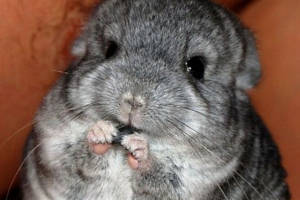 The front teeth grow in the chinchillas all the time and they need the material for grinding the incisors. For this purpose, the birch, lime, alder, hawthorn and apple tree branches are placed in a cage.
The front teeth grow in the chinchillas all the time and they need the material for grinding the incisors. For this purpose, the birch, lime, alder, hawthorn and apple tree branches are placed in a cage.
Feed and water should be free from foreign odors and impurities, because spoiled food with mold can lead to acute intoxication and death. Correctly selected and competently balanced on calories diet is the source of longevity of your rodents and prevention of obesity, and in fact for today it is one of the frequent reasons for turning to a rathologist.
Features of behavior
With extreme caution, you need to pair your pet. If you decide to purchase a second animal, you need to gradually introduce them to each other:
- For three days the animals must live next door, the cells must be close to each other;
- Then prepare one common large cage, pre-disinfection and general cleaning, change the floor covering;
- Leave for 3-4 hours new friends in a small cage;
- After that, in the new "apartment" run the first male, he will mark the entire territory;
- And the last place the female.
By observing such rules, you will avoid fights and injuries to your animals.
The change in the behavior of the animal can be related to the period of estrus. The chinchillas run regularly at intervals of 40-42 days. This period lasts from two to seven days. Hunting is characterized by a decrease in appetite and an increase in activity, the sexual organs swell and become hyperemic. If you live a pair of chinchillas, at this time there is a great chance of mating and further offspring is expected in 110-115 days. If you do not want offspring, it is better to plant the male for the period of estrus.
It should be noted that the peculiarity of the chinchilla behavior is shyness and the room with the dwelling of the rodent needs to be left in silence. All manipulations with the animal should be done slowly, without sudden noises and movements, introduce something new gradually and reduce stress for the animal.
Bathing chinchillas and caring for the hair
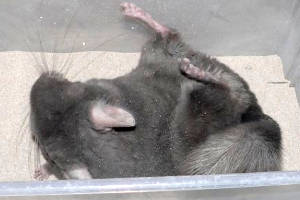 To care for the hair of chinchillas, it is necessary to regularly brush it and provide the rodent with good sand for bathing.
To care for the hair of chinchillas, it is necessary to regularly brush it and provide the rodent with good sand for bathing.
The first in the life of the combing rodent should be started with a brush with sparse teeth, so that the animal gradually gets used to new sensations and is not afraid of this manipulation. Talk kindly to the beast, do not make sudden movements. Over time, the pet will get used, and it will be possible to use a brush with frequent teeth and comb the deep undercoat, as expected. Teeth should be rounded, so as not to injure the pet's delicate skin.
Sand is better to use special, because in nature chinchillas are bathed in volcanic ash. The usual river sand is capable of breaking delicate hairs and hammering the wool. By the way, experienced breeders use zeolite dust before exhibitions. Such a composition raises the undercoat, makes it even more airy. The fur begins to pour into the light, after such a bath the animal looks very well-groomed. The only drawback of this procedure is this fine dust, which sits on all the objects around the showcase of the animal.
Bathing in the water chinchillas can not, because they do not have sebaceous glands and they get wet through. Bathing should be done at least 3 times a week, for an hour, although animals enjoy bathing for hours, but with long bathing, the hair can dry out.
The correct content of chinchillas in an apartment, a well-equipped spacious cell, a well-thought-out food base, a good organization of the bathing process and active night games, this minimum is necessary for a long and happy life of the rodent, which will in return please you with your attention and remove your fatigue after a long working day. And your children can watch for hours the habits of a funny fluffy beast, positive emotions for the whole family are provided for many years.
Recently, more and more popular among urban residents, began to use chinchillas, as pets. In fact, this is not surprising. Having a long experience in keeping different animals in the apartment - I can say that the chinchillas have practically no shortcomings in the content! Of course, if you can, or rather say - you want to create the right conditions for life.
Let's start with a brief description:
Chinchilla - rodent. In nature, in their homeland - South America, they are very, very few. Therefore, chinchilla is listed in the international Red Book.
The closest relative of the chinchilla is a wild-type, although they are not similar in appearance. Very similar to rabbits and squirrels, they have no direct relationship, although they are very similar in content to both.
It's a chinchilla of ordinary, gray color. Such chinchillas were first brought to Russia in the middle of the last century for study and adaptation in our country. The experiment of acclimatization in the nature of our country was never completed.
The genus Chinchilla has only two kinds:
- Chinchilla Longtail, it is small or mountainous.
- Chinchilla short-tailed, it is large or flat.
Actually the long-tailed chinchilla became the object of home keeping and breeding. Of course, initially the chinchillas were bred for obtaining valuable, warm and unusually beautiful fur, but over time, chinchillas from the category of fur-bearing animals moved into the category of pets.
Acquisition of the animal is better with the breeders. Come home, see how animals are kept at home by people. Of course, not everyone is allowed to go home, but some owners of domestic nurseries even insist on personal contact. There you can see the parents, brothers and sisters of your future favorite yourself, and you can choose.
Take chinchillas to your home from two months old, it's even better to take a baby, not an adult beast. they are better at getting used to the hands and new owners. A healthy, strong baby has clear and clean eyes, a clean, not wrinkled coat and a cheerful look! It is necessary to see how the baby drinks and eats, take with him a little of the food that the breeder feeds. Look at how the cells or shop windows are arranged in which the chinchillas live with the breeder to have an idea of the content. You can read many times and not imagine, and once you see, you can already make a lot of conclusions for yourself. One such visit to a private nursery turned my life forever. I passionately "fell ill" with these animals!
You can keep one chinchilla in a cage. The cage should be at least 50 x 50 cm around the perimeter of the bottom, and a height of at least 60 cm. The rods must be metal, not laminated. A deep pallet with bars above it. The distance between the rods should not be more than 1.5 cm. In the cage, at different heights, it is necessary to install several shelves 10-15 cm wide, a house, a drinking bowl and a feeder. All internal equipment must be firmly attached to the walls. otherwise it will all be toys - rattles for your beast. In a metal cage and night silence, all these rattles will be an irritating factor for you, and with the maintenance and upbringing of chinchillas irritability and nervousness are unacceptable!
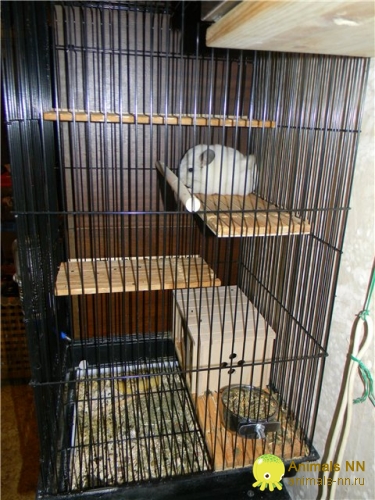
Feeding home chinchilla is very simple. They feed on special, granulated fodder, a little dried carrots, other root crops, oat seeds, a piece of dried apple and a zest, and a pinch of hay - that's all! Do not give any fresh vegetables, fruits and herbs. They do not have any human and other food - this will lead to a fatal illness! Zest and dry apple - this is a treat and encouragement and there should not be a lot of them. In a day the adult chinchilla eats 2-3 table. spoons of dry mixture and a small piece of hay, the water in the automatic drinking bowl should be kept in the cage constantly! Thus, at a cost of 100-200 rubles. per kilo and a small daily rate - feeding will not be expensive!
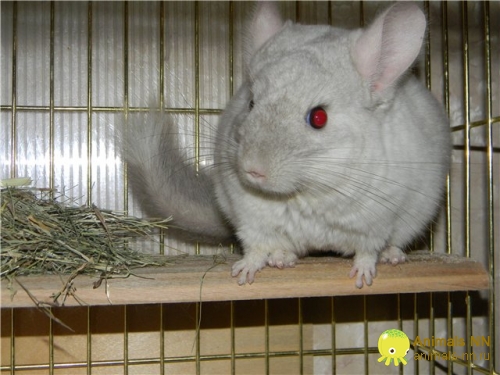
White pink velvet.
When in the cage, a sawdust or granulate is placed on the entire area of the pallet for the toilets of cats and rodents and covered with a grid of the bottom of the cage. When the content in the storefront on the floor is not poured anything - the filler is poured only into the tray - the toilet, where the beast will go to cope with a small need. To control the production of boluses (shit) shushi can not and therefore scatter them everywhere, but they are dry and do not stick. All the products of the life of chinchillas do not smell at all! Even if you do not change the filler in the cell tray for a whole month - you will not even feel the smell. Try to do so in a hamster, a rat or a guinea pig.
In recent years, an unusual set of chinchilla stains has been derived. Gold Bar, blue diamond, violet, sapphire, white pink velvet, etc., all are the colors of chinchillas. All of them are almost identical in appearance, but absolutely different in quality and color of wool.
More recently, a new breed of chinchillas, the Royal Persian Angora, was bred and appeared in our country. This is a very unusual animal! A large, round head, small ears, big eyes and a cheeky muzzle make Angora an absolutely cartoon character!
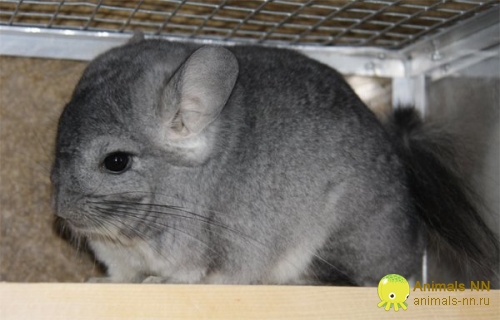
Royal Persian Angora standard color. Photo from the site Angor from the sales section.
I especially want to focus on the education of chinchillas
If you do not even take into account the sweet, amusing shape - the chinchillas have enough good qualities and character one of them. Shushi do not bite or scratch, unless, of course, you hurt her! The baby you raised will be tame and faithful, like a puppy. Chinchillas have considerable intelligence and can be trained to walk around the room and return to the cage at the command of the owner. But thanks to just a lot of intellect and some telepathic abilities (it is scientifically not proven, but many breeders assure), some chinchillas literally subordinate their masters to themselves and literally sit on their heads. Proper education, timely encouragement and regular communication - this is the main pledge in the cultivation of a good pet.
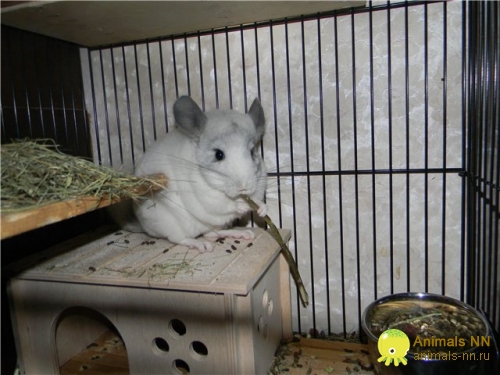
White hetero ebony.
In breeding, chinchillas are a very fertile material for breeding. Many genetically fixed colors can cross between themselves and give offspring, the color of which can be pre-calculated. Bearing different colors simultaneously in the same manufacturer can give, with the right selection of a pair of very interesting combinations and colors. The appearance of new colors is unlikely, but what we now have has incredibly great potential! White, gold, black, brown, blue, purple - an incredible variety of colors and shades of color - that's what we have at the moment in the colors of these wonderful animals.
I think that thanks to all that I've listed, thanks to what you learn yourself, when you start this animal and tell others - thanks to all this, chinchillas will spread more and more in our homes and make our hearts a bit softer and warmer!
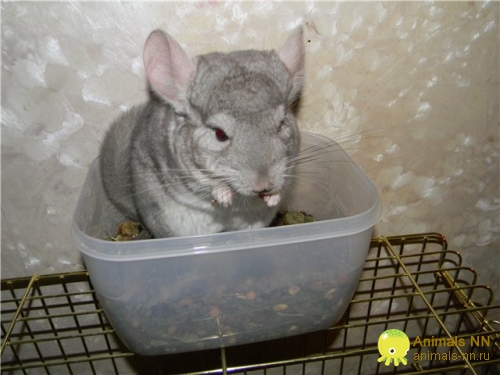
Heterochrome beige.
Grow chinchilla at home
Some people, seeing a chinchilla, can not resist her charm. This animal has a funny appearance. Deciding to start this animal, as a pet, you should know a few nuances. First of all, it must be taken into account that chinchilla at home requires a lot of care and care. The natural habitat of chinchilla is South America. Usually these animals choose their habitat in the mountains.
What is an animal?
Some people believe that this creature is quite expensive for a pet. Prices for chinchillas fluctuate within 200 dollars. We agree that this pleasure is not for everyone. But the cute appearance of this animal is very captivating. This creature looks defenseless and needs daily care. If you are ready to take on this heavy load, then it is worth taking into account several features when caring for a chinchilla.
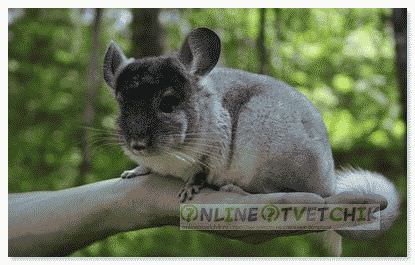 Beautiful, puffy animals
Beautiful, puffy animals Usually, the chinchilla at home is not whimsical. The main thing that you must buy is a high cage. Chinchillas do not tolerate inconveniences and small space. Moreover, the cage must necessarily be equipped with shelves made of wood. They should be located on several floors. This will allow the chinchilla to lead an active lifestyle and jump.
Chinchilla at home requires her cell to have everything necessary for her comfortable existence. First of all, it is necessary to equip the habitat of the chinchilla, and in this case it is a cage, a drinker. The fact is that chinchillas are very fond of drinking. To ensure that the drinking bowl is firmly attached and the chinchilla can not gnaw it, it should be strengthened from the outside of the cage. This is a very important point.
The next point that you should take into account is that the water in the drinking bowl should change regularly, and its quality should be high. It means that the chinchilla is not suitable for ordinary water from the tap. Before you pour the animal water, you must filter it. It is very important. If you pour chinchilla water with bleach, then do not be surprised if in the near future it becomes unwell. As for water, everything is clear.
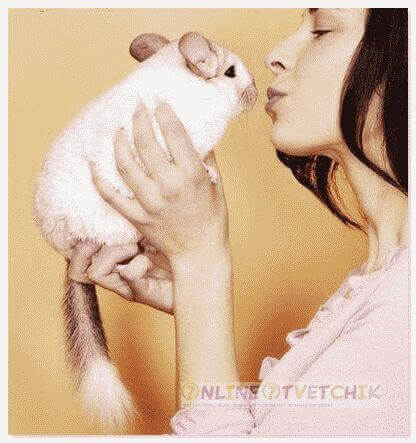 Contain the chinchilla at home
Contain the chinchilla at home We pass to the food of the chinchilla. To the animal was comfortable to eat, you need to put in a cage a small bowl with food. We recommend that you choose a metallic option. If you can not decide on the food, you should buy several options for food in the pet store. The beast will choose for itself the food. You can diversify the feed of the animal with rice or buckwheat. Chinchillas in some cases like to feast on raisins.
But keep in mind that an overabundance of raisins can negatively affect the health of a chinchilla. Therefore, raisins should be given every few days in small quantities. These animals are very clean. Therefore, you need to put hay a day in their place of habitation. Chinchillas are very fond of and appreciate. If you want the chinchilla to have no health problems, then you can feed it at a certain time every day. If you follow the regime, then the chinchilla will not be able to get sick.
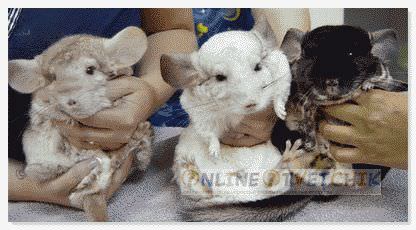 Care for chinchilla babies
Care for chinchilla babies We recommend that you feed the beast in the evening. It is preferable to install a wooden house in the cage. This will be an excellent refuge for the animal, which can sometimes experience fears. If you want to create a chinchilla all the necessary conditions. It is necessary to install a stone in the cage, which will be folded for chiselling teeth. Chinchillas love hammocks. To meet the needs should be purchased wood filler.
Breeding chinchillas at home
Swim, oddly enough, the animals love in the sand. It must also be purchased. Some people buy chinchilla for profitable business. In order to ensure the breeding of chinchillas at home, several things should be considered. This is not a very complicated matter. But you should know that there are several ways to do this. You can breed animals in a traditional way, which means one female and one male, and you can use 2 females and one male at a time.
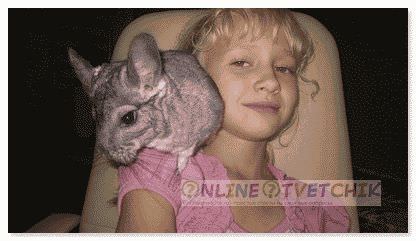 To raise chinchillas at home
To raise chinchillas at home In some cases, you can use three or four females and only one male. Breeding chinchillas at home will require you to purchase a large cage. There must be shelves in it. It is also very important that there is a house in the cage where the female and her offspring will be located. After the kA progeny reaches the age of 3 months, it should be separated from the mother in a separate cage.
The contents of the chinchilla, the image of which you see in the photo, as well as its offspring, will require you even more. To do this, you will need to purchase additional cells, and with them all accessories to them. Note that the male will need to be plucked from the chinchilla by the female immediately after the third lambing. This is very important, since three lambs in a row the animal can not stand and just die. Usually after the advent of 105 days from the time of the very first lambing, the male is planted. This rule must be observed, otherwise you may incur losses.
How can you feed the animal?
How to feed the chinchilla you know, in order to understand this better, you can see a detailed video. Know that feeding an animal is also very harmful. This is worth considering. Give chinchilla a variety of food, then it will grow faster, it will allow it to develop and give healthy offspring. Sometimes the chinchilla has to be taught to the toilet by herself. To do this, you need to lay a mat with a fairly stiff nap. Let him be out of the carpet.
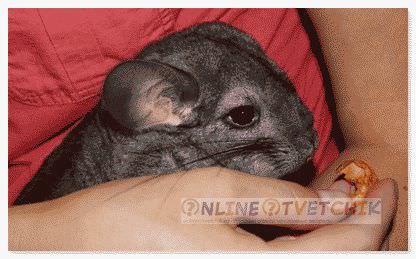 Feeding the chinchilla
Feeding the chinchilla In the corner of the cell should be marked with a toilet. We recommend that you buy a corner toilet. Let its edges be about 5 cm. Place the wood-based filler in the tray. Let the filler be as long as necessary to close the bottom of the tray. In order for the beast to learn to walk to the toilet, rather than throwing its waste around the perimeter of the entire cell. It is worth it to deceive and artificially collect all his waste in the toilet. This will provoke him to cope with his need in a specially designated place.
How do animals behave at home?
The behavior of chinchillas in the house can be very different. They can rush around the cage, and can sleep for days on end. These animals are very unpredictable. Chinchillas often require increased attention. They can all chew and constantly sharpen their teeth, for this, as mentioned earlier, they need to purchase a special stone. These animals can be excessively mobile.
 Behavior of the animal of the house
Behavior of the animal of the house In the pet store you can pick up a toy for them. Once every 3 months, you can take the chinchilla to a veterinarian for a general examination. Chinchillas should not start small children. This animal requires complex care, which only an adult can do. If you properly care for the animal, then it can live a very long time. Chinchillas are very cute animals, they are always grateful to their masters.
Video
Recently, among domestic pets, chinchilla is very popular, caring for such a small animal is not particularly difficult. An exotic animal comes from the mountainous regions of South America, but it is easily attached to a person, caring for it is more like a pleasant trouble. In response, the cute fluff will give a lot of positive emotions to all family members.
Chinchilla - description
These exotic animals belong to the detachment of rodents. Description of breed:
- pets grow to 38 cm, the tail has a length of 10-17 cm;
- the weight of the animal reaches 800 grams;
- the head of the animal is rounded, the neck is short;
- the body of the rodent is covered with strong and dense fur, which in nature easily heats it in the highlands. It is an industrial value used for sewing fur products;
- the animal has rounded ears up to 6 cm high;
- the tail is covered with stiff long hairs;
- rodents have black round eyes;
- the animal has strong hind legs that are twice as large as the forelegs, and allow them to bounce high;
- the standard color of the rodent is bluish-gray (ashy). Less common are black and white individuals.
Animals are bred for fur by farmers and are popular as pets. Proper care for chinchilla includes competent arrangement of the cage, balanced feeding, cleaning. The advantages of such pets are that they do not have sebaceous glands and do not have an unpleasant odor. In addition, the animals do not shed, they always have a clean and pleasant to the touch fur. They do not bite, do not scratch and are well suited to education. Animals are interesting in their behavior, they make funny sounds, similar to tweeting or quacking.
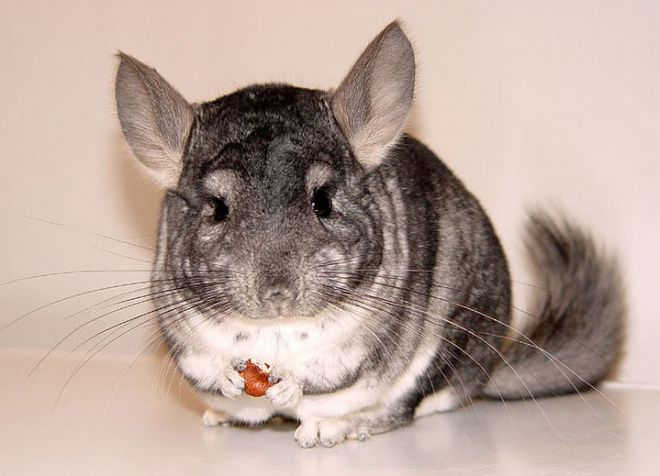
Life expectancy of chinchillas at home
If you properly provide chinchilla care and maintenance, then as a pet, she can live up to twenty-five years. But this time depends on how well the owner will monitor his fuzzy. It is important to know the characteristics of the content of chinchillas, the factors that affect:
- Exotics can not stand the heat. The temperature regime in the room should be given special attention.
- To increase the life expectancy of the animal, as care it needs frequent bathing in a special sand. This clears the fur and relieves stress.
- Carry out the correct feeding. Ensure that animals do not eat grapes, nuts, seeds, branches of stone and coniferous trees, newspapers, wallpaper.
Chinchilla content at home
In the apartment, keep the chinchilla in a cage or window. But such animals are subject to stress. Therefore, to make the rodent feel good, you need to know how to contain the chinchilla at home. When choosing a place to install a home, factors such as temperature and lighting are taken into account. Also, the pet does not tolerate drafts and overheating. Chinchilla - care and conditions of detention:
- The house is set in a shaded and quiet place. Zverek leads a nocturnal lifestyle, so if you put his home in the bedroom, he will prevent the hosts from resting.
- The maintenance of pets in very warm rooms causes them a heat stroke and cardiac arrest. The optimum temperature for rodents is 18-20 ° C. The lower will cause them to decline activity and appearance.
Contents of chinchilla at home - choose a cage
The rodent likes to move, he needs a spacious cage with dimensions of at least 50 cm by 50 cm and a height of 60 cm with metal rods. The dwelling is important to equip. What you need to keep chinchilla:
- a small enclosed lodge for privacy where the animal can hide;
- equip a lot of moves and shelves, ladders, rings, (wooden);
- a drinking bowl (or screw the usual, so as not to turn over);
- a feeder hinged or heavy, so as not to be thrown;
- salt or mineral stones (serve as a source of useful substances);
- toilet with filler in the corner;
- nursery for hay;
- filler as litter on the floor.
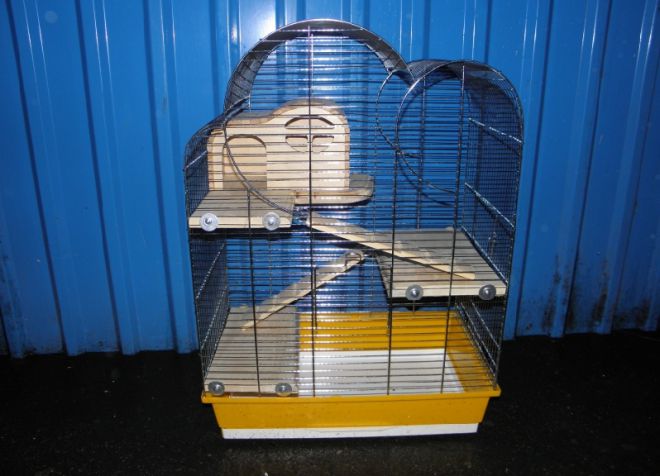
Chinchillas - cons of content
Such an exotic animal attracts soft wool, unpretentiousness in the care, absence of an unpleasant smell. But you need to know what difficulties can be encountered in the decision to acquire such an unusual pet. Contents of chinchillas - cons:
- the animal can escape from the cage, often opens the door itself. Then it must be painfully to seek;
- when walking around the apartment a pet gnaws everything - wires, shoes, furniture. It is impossible to get rid of this from it;
- the pet needs frequent sand baths, from which a lot of dust is formed;
- rodents do not tolerate changes in temperature and high humidity;
- they do not like to sit on their hands;
- it is difficult to find a doctor if necessary treatment.
Care for chinchillas at home
Such rodents are by nature shy. It is important to know how to take care of the chinchilla at home and build a trusting relationship with her. When the animal appears in the apartment, he needs to give the first few days to get used to and not touch. Then you can open the door, gently place the rodent hands and repeat his nickname. The pet will respond to the game over time and begin communication. The main thing - do not scare and do not strongly impose, treat a delicacy - half a raisin. Chinchilla - care for the pet and the cage:
- drink the boiling water with boiled warm water, change every 2-3 days;
- litter and toilet are updated once a week;
- the cell is thoroughly washed with detergent once a month;
- the sand for bathing is sieved once a week, varies once a month.
What to feed the chinchilla at home?
Eating chinchillas at home is very simple - the basis of the ration is hay and granulated fodder. In a day an adult animal eats 2-3 tablespoons of a dry mix, it should be given once a day at the same time - closer to the evening. Hay needed for normal operation of the intestine. In food, you need to add leaves of dandelion, nettle. Delicacy for the pet will be dried apples and pears, karkade. Do not give fresh vegetables, fruits, seeds or grass. All ingredients are sold at a pet store.
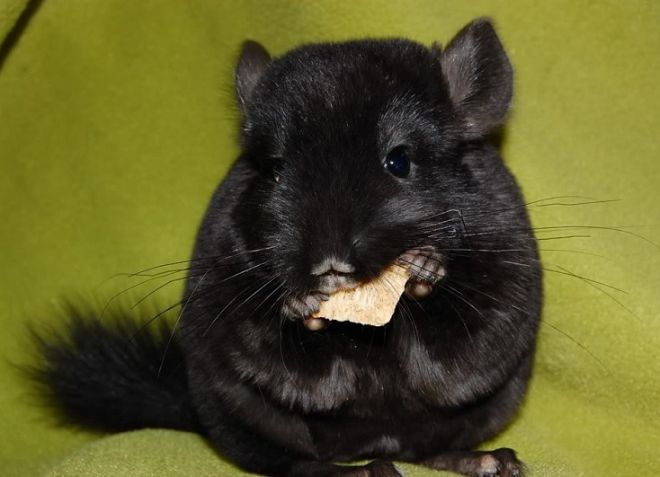
Home chinchilla - do I need to wash it?
Because of the chic fur fur water shower is categorically forbidden for pets. Care for chinchillas in the apartment involves mandatory bathing of rodents, which is performed several times a week. For this, a bath with special sand is used. In such a container the animal with pleasure tumbles, after "bath" it becomes beautiful and cheerful. There is a special sand with anti-inflammatory therapeutic effect. Leaving the container in a cage is not always recommended - the animal will swim too often, and dry its skin.
Breeding chinchillas at home
Sexual maturity of rodents is reached at the age of seven months, in a year they are able to bring 2-3 litters for 1-3 cubs. Mating animals at night, to determine that the reproduction of chinchillas at home will be successful, you can by lump wool on the litter. The duration of pregnancy is 105-115 days. Care for the female during this period: increased feeding, remove the male from the cage and, before the appearance of the offspring, cover the house with fresh litter. Childbirth occurs often in the morning and does not require outside interference.
Babies are born sighted, with teeth and hair. They weigh about 70 grams, move around, so the bars in the house are needed very often. They do not need additional care - the mother feeds them herself. But if the offspring sits, hunched with a lowered tail, it may be necessary to give them artificial milk from a glass pipette. The lactation period lasts up to 60 days, then the young are planted in a separate cage.

Recently, people prefer to have exotic animals instead of cats and dogs. Among the four-legged friends, ferrets and chinchillas are gaining wide popularity, we will stop at the last. Chinchillas are small furry creatures scurrying from corner to corner. Animals are characterized by self-will, kindness and love for people. Consider the important aspects in order.
If you are just planning to start a chinchilla as a pet or already a master of a fluffy lump, it makes sense to consider basic care right down to the smallest detail. Chinchillas can live about 15 years at home, if all the conditions regarding feeding, habitat, bathing and other nuances of content are met.
Cage for chinchilla
To successfully contain the chinchilla at home, it is not necessary to build a complex structure like the one that is built on farms. It is enough to buy a cell of the right size and equip it properly.
The optimal size is 60 cm in height, 60 cm in width, 70-80 cm in length. If possible, buy a larger cage, it all depends on the finances. To facilitate the life of the host will help the requirements that the cell must match.
- If you plan to breed chinchillas at home, the distance between the rods of the cage should not exceed a mark of 2 cm. Otherwise, the newly born babies can easily slip out of the house, making both the female and the host nervous.
- Chinchillas love coziness and darkness. For these purposes, it is necessary to purchase a plastic house with a roof in which the animal can sleep or hide in case of poor health or fear. The cage should be equipped with a pallet, into which chips or sawdust is poured. The filler should be changed 1 time in 5-7 days, whenever possible more often.
- A cell must contain a vitaminized stone. Chinchilla refers to rodents, for this reason it needs constant sharpening of the teeth. In addition to the fact that the animal grinds teeth by mechanical means, it will also collect useful minerals and macro elements.
- To comply with the rules of chinchilla at home, you need to put a cage and a drinking bowl in the cage. Attach bowls to the door or wall of the enclosure. Do not place containers on the floor, otherwise the animal will constantly turn them over. In addition, the food will be sawdust and waste. The pet refuses to eat, because it is excessively clean.
- Chinchillas are herbivores, for this reason you should always have hay or fresh grass in your arsenal. For this purpose, equip an additional tray in the corner of the cage. If desired, you can make a hanging feeder for hay from the net, it all depends on personal preferences and the size of the dwelling.
- Pets like this prefer to sit on a hill, rather than in the lowlands. Build a shelf for an animal, if possible make a few pads. You can build a structure from several shelves, so that the pet jumps from one step to another.
- In the pet stores special antibacterial sand is sold for rodents. If you have enough space in the cage, get the composition and make a kind of bath. Chinchilla will burrow in the sand, cleaning the wool.
- Chinchillas are the cleanest creatures of all available rodent species. The litter of the pallet needs to be changed regularly as it gets dirty, with a general cleaning of the cell once a week.
Chinchillas are fastidious animals in terms of eating. If you accustom a pet to one diet, switching to another will be quite problematic.
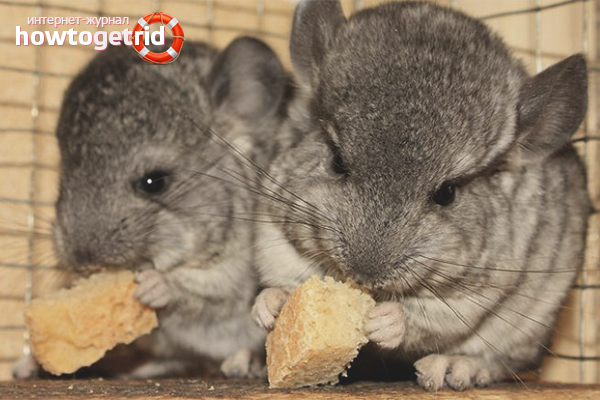
- During the acquisition of the animal from the breeders inquire what kind of food they gave to the animals. Learn the brand, name, series. If possible, buy a ready mix with chinchilla. At the same time, it does not matter which kind of pet you decide to have (onshore or small long-tailed), taste preferences are different for everyone.
- When choosing a feed, pay attention to the expiration date. Give preference to varieties of premium class. If there is no possibility, mix "lux" and "economy" in a proportion 1: 1. As a rule, breeders feed the mixture with a mixture of wheat and rye bran, oats, wheat germ, barley, flour of all sorts, minerals and vitamin supplements.
- Concerning the frequency of feeding, the procedure is carried out twice a day. A portion of the granulated food for an adult is 60 grams. To diversify the food, give the pet fresh grass or hay, but do not mix the two kinds among themselves. Chinchillas are not indifferent to carrots, cabbage, apples, pears, dried apricots. However, the listed products can be given in the form of a treat.
- Domesticated chinchillas often need vitaminized complexes that are sold in pet stores. Find the optimal composition will help the veterinarian, when you lead the animal for the first vaccination. As a rule, vitamins should be given twice a year. Additives are available in the form of a powder or gel, which dissolves in water and is poured in by a syringe.
- Chinchillas love the sweet. For a piece of chocolate or raisins, they will serve you on small hind legs. It is important to be careful during feeding with a delicacy, an animal can develop an allergy. Spoil the pet no more often than 1 time in two weeks.
- Every day, change the pet water in the water bowl. The liquid must be clean, filtered, and drinkable. Do not drink your pet with running water to prevent intestinal distress.
Temperature for chinchilla content
In the wild, chinchillas live in temperate climates. Because of the thick fur, they can not exist in the heat, so it makes sense to talk about the optimal temperature regime in the apartment.
- To make the animal feel comfortable in the summer, it is better to install a split-system (air conditioner). In cases where the temperature crosses the mark of 28 degrees, the chinchilla can die from a heat stroke.
- The optimal conditions for keeping the animal are the indicators from 18 to 23 degrees. Do not allow hypothermia, make sure that the mark does not fall below 15 degrees.
- Place the cage with the animal away from direct UV light. You can periodically release a pet to bask in the sun (loggia, balcony, street), but not in the peak of activity. The best time for a walk is 18.00-20.00. Do not keep the chinchilla in the sun for more than a quarter of an hour.
Accustoming a chinchilla to the toilet
- Chinshill must necessarily be accustomed to the tray, otherwise it will shit in the corners of the apartment. Get a special corner tray in the pet store, designed specifically for ferrets and chinchillas.
- If the animal will cope with the need for the entire area of the cage, collect the feces in a specially designated place. The pet will feel where he needs to cope with the need. Take the waste from the tray once every 3 days.
- When the chinchilla comes off in the tray, praise her. Repeat the action each time until the animal is used to it. At the end of time, you will notice that the animal is asking for affection, wanting to please the master in everything.
- If you will let the pet run around the apartment, set one tray in each room. Plant an animal in the toilet as soon as you see that it is looking for a place for similar purposes.
It is very difficult to breed chinchillas at home, especially if the animals are kept in the apartment.
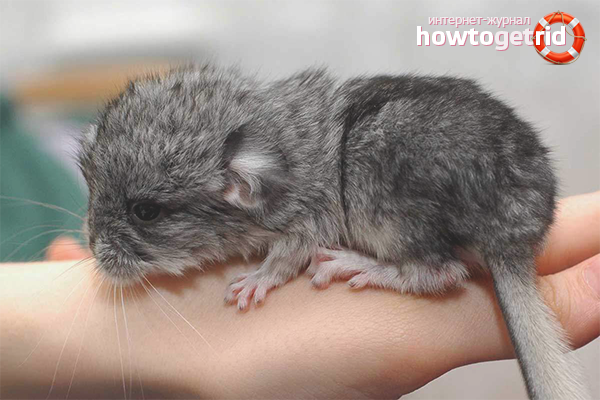
- The females are quite selective, they do not allow each of the males to approach themselves. If partners for sexual intercourse do not have mutual sympathy or are irritated in the presence of each other, they begin to lose weight and fall into a prolonged depression.
- Sexual maturity in chinchillas occurs after 7-8 months from the moment of birth. If we are talking about females, they grow up a month earlier.
- Progeny is healthy and strong only if the pregnancy occurs 1 time in six months. If the female bore cubs more often, the offspring will turn out to be of poor quality, the babies will get sick. If we talk about reproduction in captivity, it goes badly.
- The total duration of pregnancy is about 4 months. In most cases, the childbirths proceed without complications, then the female eats the placenta. At one time a mother can tolerate about 3-6 children.
- In female chinchillas, mammary glands are poorly developed, only two out of six work in full-fledged mode. Toddlers grow extremely slowly, but after 1.5-2 months they already need to be weaned from their mother.
Basic rules for chinchilla content
- Do not allow the pet to move freely around the apartment without your supervision. In cases, if you give the animal such a habit, it will ask to leave the cage daily.
- Chinchillas have a habit of gnawing wires, wallpaper, furniture upholstery. They also like to climb into hard-to-reach places, from where it will be difficult for owners to rescue them.
- Do not feed the pet with ordinary food (sausage, porridge, potatoes, etc.). An animal can develop indigestion and blockage of the intestines, which will lead to a fatal outcome.
- The behavior of chinchillas is unpredictable in most cases. They can sleep for days on end or run around the cage without tires. In the first case, do not worry, in the second - take the pet in his arms and play with it.
- If in the house in addition to chinchilla live cats or dogs, do not allow animals to contact without your participation. Always hold the rodent on your hands, allowing the rest of the pets to smell it.
- If you plan to walk with a chinchilla on the street, pre-take the pet to the vet. Make vaccination against rabies and plague carnivorous, proglistognite pet. Do not release it from the harness.
- Chinchillas are a type of animal that begins to ache due to stress. For this reason, pets are often not recommended to be transported from city to city, and also to squeeze (important for young children).
- Do not place the cage near radiators or, on the contrary, in a draft. Since chinchillas are afraid of noise, do not put a house next to the TV, speakers, dishwasher, refrigerator and other household appliances.
The character of the chinchilla will only be fully revealed when the owner creates all the conditions for this. For exotic pets should be carefully looked after, they need constant attention and care. Do not neglect the basic rules regarding nutrition and housing arrangements.

